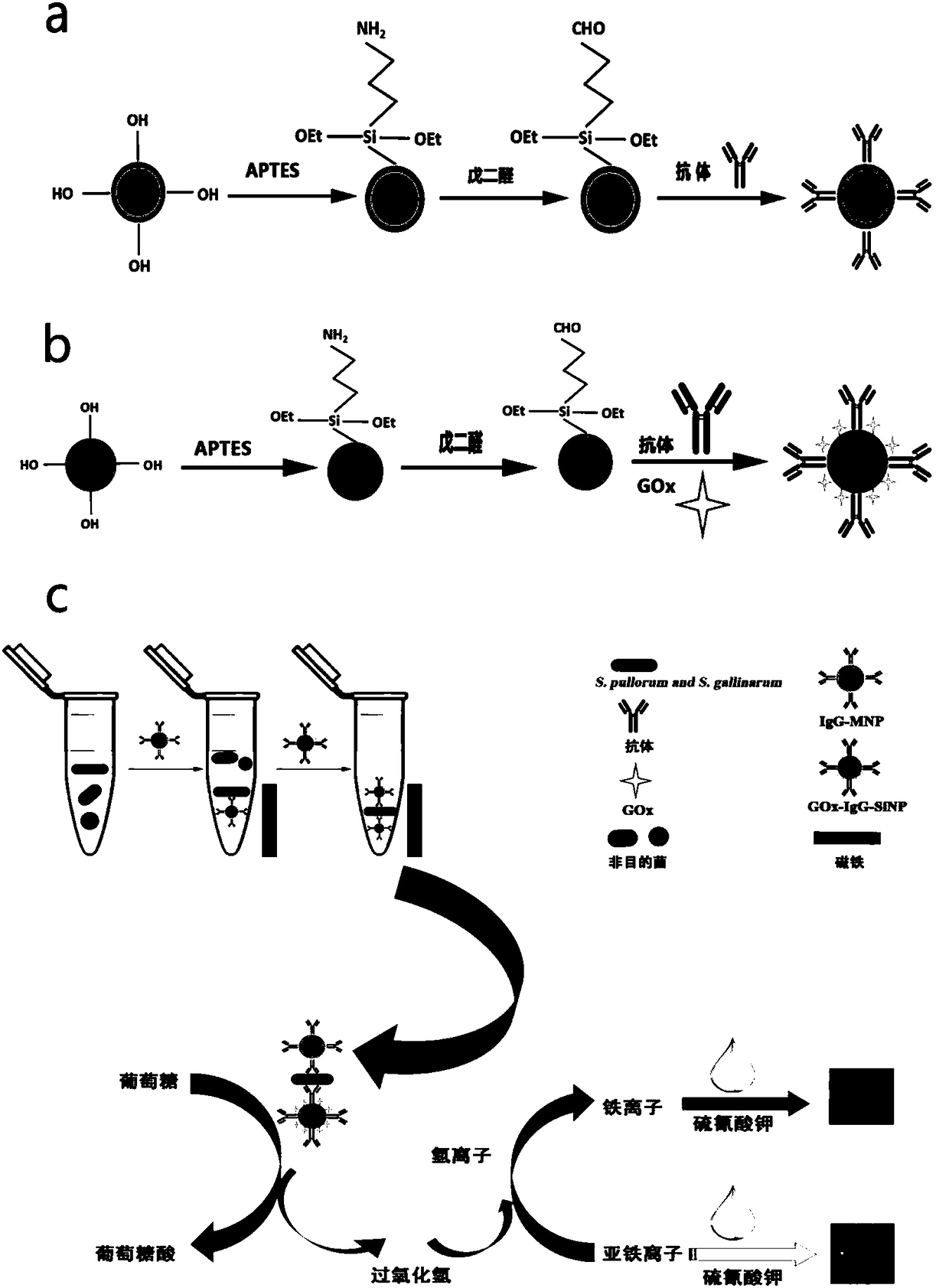Non-diagnostic purpose method for quantitatively detecting Salmonella pullorum and Salmonella gallinarum
A quantitative detection method, the technology of Salmonella, applied in the direction of measuring devices, instruments, scientific instruments, etc., can solve the problems of poultry breeding industry loss, threat to food safety, etc., and achieve good sensitivity, convenient detection method, and easy operation.
- Summary
- Abstract
- Description
- Claims
- Application Information
AI Technical Summary
Problems solved by technology
Method used
Image
Examples
Embodiment 1
[0046] (1) Synthesis of silica nanoparticles (SiNPs):
[0047] SiNPs were synthesized by the inverse microemulsion method. The specific synthesis process is as follows: 2mL Triton X-100 (surfactant), 2mL n-hexanol (cosurfactant), 8mL cyclohexane (organic solvent) were stirred for 20min until clear and transparent, and 480μL ultrapure water was added as the dispersed phase , stirred for 20 min to make the water droplets completely dispersed in the above oil phase to form a uniform and stable W / O microemulsion, and then added 100 μL tetraethyl orthosilicate (TEOS) as a precursor for the synthesis of SiNPs, and stirred for 30 min. Add 100 μL of ammonia water (catalyst) to the system solution to promote TEOS to form nano-microspheres through hydrolysis and condensation reaction faster. After 48 hours of magnetic stirring, 10 mL of acetone was added to demulsify the microemulsion, and the precipitate was collected after centrifugation at 10,000 rpm for 5 minutes, and then washed t...
Embodiment 2
[0060] Example 2: GOx triggers an enzymatic cascade to bind Fe 3+ -SCN - Establishment of quantitative detection method for pullorum pullorum and Salmonella gallinarum typhi by colorimetric system
[0061] (1) Optimization of the concentration of antibody-coupled nano-magnetic beads
[0062] Change the concentration of antibody-coupled nanomagnetic beads IgG-MNPs: 2.4mg / mL, 3mg / mL, 4mg / mL, 6mg / mL, 12mg / mL, 24mg / mL, 48mg / mL, other experimental conditions are the same as the implementation The same as Example 1, quantitative detection of 1mL 10 7 CFU mL -1 The samples of S.pullorum and S.gallinarum to be tested. Depend on figure 2 It can be seen that as the concentration of IgG-MNPs increases, the absorbance value gradually reaches the maximum value and then maintains a plateau period and then shows a downward trend. Therefore, the optimal concentration of IgG-MNPs for analysis and testing is 6 mg / mL.
[0063] (2) Optimization of enzyme marker concentration
[0064] Chan...
Embodiment 3
[0065] Embodiment 3: Sensitivity detection
[0066] Detect 8.4×10 under the condition of embodiment 1 0 CFU mL -1 to 8.4×10 7 CFU mL -1 Pullorum and Salmonella gallinarum (S.pullorum and S.gallinarum) were used to determine the sensitivity. The relationship between the absorbance value and the concentration of Pullorum pullorum and Salmonella gallinarum typhi is as follows: Figure 4 As shown, when the concentration of S.pullorum and S. gallinarum is 8.4×10 3 CFU mL -1 to 8.4×10 7 CFU mL -1 When changing, the absorbance value has a good linear relationship with the log value of the concentration of S.pullorum and S.gallinarum. The linear equation is y=0.1992x-0.31102, the coefficient of variation R 2 = 0.98706. The detection limit of the method for the target bacteria S.pullorum and S.gallinarum was 2.36×10 3 CFU mL -1 .
PUM
 Login to View More
Login to View More Abstract
Description
Claims
Application Information
 Login to View More
Login to View More - R&D Engineer
- R&D Manager
- IP Professional
- Industry Leading Data Capabilities
- Powerful AI technology
- Patent DNA Extraction
Browse by: Latest US Patents, China's latest patents, Technical Efficacy Thesaurus, Application Domain, Technology Topic, Popular Technical Reports.
© 2024 PatSnap. All rights reserved.Legal|Privacy policy|Modern Slavery Act Transparency Statement|Sitemap|About US| Contact US: help@patsnap.com










